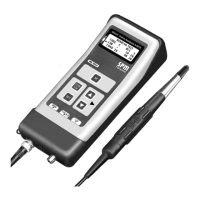10
Technical data are subject to change without notice.
ISO 9001 certified. © Copyright SPM 1996-9. 71411.B
SPM Instrument AB • Box 4 • S-645 21 Strängnäs • Sweden
Tel +46 152 22500 • Fax +46 152 15075 • info@spminstrument.se • www.spminstrument.se
Fig. 13
CODE Letters A to D, general description of
bearing condition
LUB Degree of lubrication in the rolling
interface. Displayed with CODE A, B
COND Degree of damage to bearing surfaces.
Displayed with CODE B, C, D
When it registers a valid bearing signal, the A2010 will
evaluate the reading and display:
• a CODE describing general bearing condition,
consisting of the letter A, B, C, or D.
• a LUB number describing lubrication condition in
the rolling interface between load carrying rolling
elements and raceway.
• a COND number describing the mechanical state
of the load carrying bearing surfaces.
The LUB No. is shown together with CODE A and B.
The COND No. is shown together with CODE B, C,
and D.
CODES for General Condition
CODE A means that the bearing is in good condition.
There is no detectable damage to the surfaces of the
load carrying parts, and no extreme lack of lubricant
in the rolling interface. Figure 14A shows a typical
shock pulse pattern from a good bearing: a low shock
level and a normal delta value.
CODE B indicates a dry running condition, causing an
high HR value and a low delta value (figure 14B). The
lubricant is not reaching the rolling interface, which
can have several causes, e.g. lack of lubricant supply
to the bearing, low temperature in a grease lubri-
cated bearing, or a heavy overload due to misalign-
ment, tight fit, deformed housing, etc.
CODE C is displayed when the instrument detects an
increased shock pulse level with a large delta value
(figure 14C). This points to beginning surface dam-
age.
CODE D is displayed when the A2010 recognizes a
signal that is typical for bearing damage: a high shock
level with a large delta value (figure 14D). A contami-
nation of the lubricant by hard particles causes a
similar pattern.
The message of the codes is supported by an arrow
pointing at the green - yellow - red scale beside the
display:
green - good condition (CODE A)
yellow - reduced condition (CODE B, C)
red - bad condition (CODE D).
Evaluated Shock Pulse Readings
BEARING TEST
CODE B Acc 3/3
LUB 0 LR 24
COND 28 HR 22
CODE A
Good condition
CODE B
Dry running
CODE C
Reduced condition
CODE D
Bearing damage
Fig. 14

